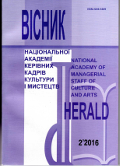THEORETICAL-METHODOLOGICAL APPROACHES TO UNDERSTANDING OF ETHNODESIGN IN THE MODERN PERIOD OF CULTURE CREATIVITY
DOI:
https://doi.org/10.32461/2226-3209.2.2016.138521Keywords:
ethno-art traditions, ethno-design, cultural practicesAbstract
The purpose of the study. The study determines the important role of Ukrainian ethnic art traditions in the style solutions of the design objects. The author researches special features of ethno-design in the context of cultural practices and defines its concept. Methodology of the research. The following are the main methods of the study: historical and art, social-cultural and system-structural. They reveal the influence of the decorative art on ethno-design development, show cultural stages of the society development and help to study ethno-design as a synthesis of cultural practices, ethnic art traditions and art-project creative work. Scientific novelty of the research. The author considers ethno-design in three meanings such as an idea, creative method and activity, because on the basis of ethno motives art-project creative work serves as a system of cultural and aesthetical connections, helping to develop creative thinking skills and providing professional competency and cultural development of a personality. Conclusions. The understanding of ethno-design approach in the art-project creative activity is caused by the desire to save our national-cultural identity and the necessity to represent Ukrainian cultural heritage in the modern world. Design in Ukraine is based on the aesthetic principles of decorative and applied arts, transformed for the conceptual solutions in ethno-design, which should become the main culture creative component of the high art education.
Downloads
Published
Issue
Section
License
Authors who publish with this journal agree to the following terms:
1. Authors retain copyright and grant the journal right of first publication with the work simultaneously licensed under a Creative Commons Attribution License International CC-BY that allows others to share the work with an acknowledgement of the work's authorship and initial publication in this journal.
2. Authors are able to enter into separate, additional contractual arrangements for the non-exclusive distribution of the journal's published version of the work (e.g., post it to an institutional repository or publish it in a book), with an acknowledgement of its initial publication in this journal.
3. Authors are permitted and encouraged to post their work online (e.g., in institutional repositories or on their website) prior to and during the submission process, as it can lead to productive exchanges, as well as earlier and greater citation of published work (See The Effect of Open Access).


